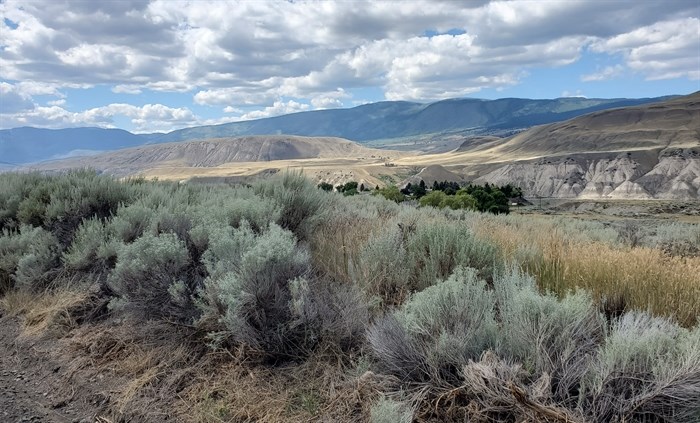
Canada's only desert — by precipitation — is roughly four hours north of Osoyoos.
(BRIE WELTON / iNFOnews.ca)
July 03, 2021 - 12:03 PM
Canada’s only desert is in the Southern Interior of B.C. but it might not be where you think it is.
They lay that claim in Osoyoos, where you’ll find the Nk’Mip desert cultural centre and where the Thompson Okanagan Tourism Association promotes the South Okanagan as a “semi-arid pocket desert.” You’ll find Nk’Mip Canyon Desert Golf Course, the Sonora Dunes Golf Course and the Osoyoos Desert Centre.
And it’s definitely a tourist draw, says Osoyoos Mayor Sue McKortoff.
“Certainly it’s the heat and weather. We have the warmest lake in Canada, and we do have a desert centre which is very popular and at Nk'Mip there’s the desert cultural centre, both of which are very good draws for people,” McKortoff says.
Thompson Okanagan Tourism Association communications coordinator Chelsea McGonigal calls parts of the South Okanagan a “semi arid pocket desert.”
“Many visitors are intrigued that Canada has a desert and are excited to learn more about the ecosystem. Many tourist businesses refer to the desert in their business name and offer desert experiences,” she says.
That’s all been great marketing because Osoyoos certainly has many aspects of a desert, including habitat. The only problem is, it’s not a desert by the most important metric — precipitation.
READ MORE: The weather phenomenon that makes our Kamloops, Okanagan paradise,
READ MORE: Why June is Kamloops' and the Okanagan's rainy season

Is the South Okanagan a true desert? Experts say there's too much precipitation, but the area does have some commonalities, sharing desert plants and animals.
(STEVE ARSTAD / iNFOnews.ca)
DEFINING A DESERT
So what is a desert? Fes de Scally is an associate professor emeritus in the earth, environmental and geographic sciences department at UBC Okanagan, with expertise in physical geography and mountain environments.
He says a desert can be defined in several legitimate ways, and there are several different kinds of deserts around the globe.
“One of the simplest ways to define a desert is based on precipitation alone, where a desert is defined at less than 250 mm of precipitation a year,” he says.
If you really want to get into it, a more complex definition is based on the ratio between mean precipitation and annual evaporation losses.
“If there is more evaporation than precipitation, then there is an annual moisture deficit,” he says.
When we showed him the work of a North Okanagan man who crunched the data, he concurred: It looks like a desert and feels like a desert but no — Osoyoos is technically not a desert.
Junah Birchwater, a self-described ‘hockey historian, climate researcher engineer, outdoor enthusiast and philosophy lover’, has researched the Osoyoos desert claim extensively for his blog, including average annual precipitation, evaporation and other factors and concluded there’s way too much moisture in the area to be considered a desert.
Given the temperatures at our latitude, Osoyoos would need to have roughly 200 mm of precipitation a year to meet the classification. Instead, its average annual precipitation is 323 mm.
That’s where a complicated calculation for evaporation comes in, but it doesn’t fall in favour either.
“There is no desert in the Okanagan because there is too much precipitation,” Birchwater concludes, pointing out even in Osoyoos there is 100 mm more precipitation than what is considered the threshold for a desert definition.
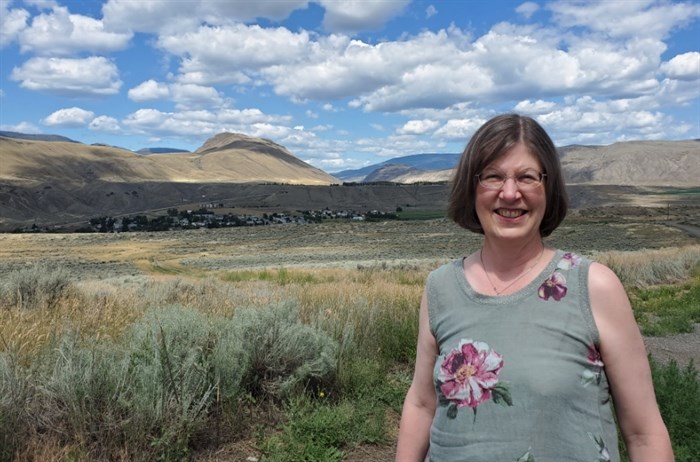
A desert? 'That's us," says Ashcroft mayor Barbara Roden.
(BRIE WELTON / iNFOnews.ca)
ASHCROFT ON THE MAP
de Scally agrees about that and about one more thing. There certainly is a desert region in Canada, but it’s about four hours north — in Ashcroft.
Although data isn’t the most complete, Birchwater’s research has led him to believe the annual precipitation rate for Ashcroft is about 205 mm a year.
"Spences Bridge, 35 kms to the south, gets 264 mm and Kamloops, 65 kms to the east, has 278 mm, so both of those towns are too wet to be classified as desert,” he says.
He says he’s done the math, and using a basis of 1.8 mm more precipitation per kilometre towards Spences Bridge and 1.2 mm more precipitation towards Kamloops, he’s figured out the rough perimeter of a relatively narrow strip of land sufficiently arid to be classified as a desert around Ashcroft.
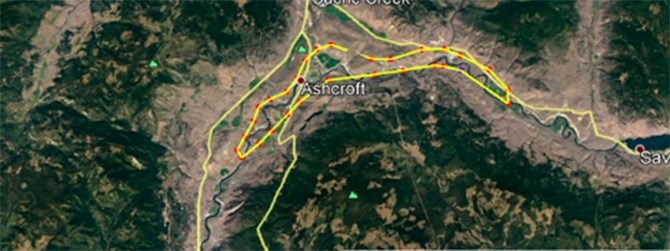
According to the research of Junah Birchwater, the only true desert in British Columbia is a small patch of ground around Ashcroft.
Image Credit: SUBMITTED / Junah Birchwater
That’s good news for Ashcroft mayor Barbara Roden, who says Birchwater "clearly knows what he’s talking about.”
“When you look at what you need to qualify as a desert, it actually is Ashcroft. It kind of bears out what long-time Ashcroftonians would tell you, without the benefit of studying this,” she says.
She says she’s read Birchwater’s criteria for what makes up a desert and has ticked off the list.
“That’s us,” she agrees.
Roden says she just happens to be about to pitch the idea of promoting Ashcroft as a desert community to the community’s new economic development committee.
“Our K-12 school here is called Desert Sands, we have our Desert Hills Ranch, which is quite well known, so we have sort of already taken the first steps into incorporating the desert into various things around here. As a marketing strategy, that’s not a road we’ve gone down, until now. It’s something worth looking at, because it’s a fascinating draw,” Roden says.
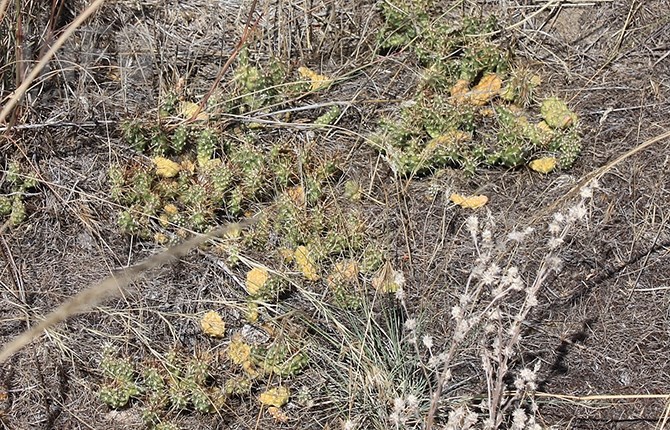
The South Okanagan is also home to desert plants such as the prickly pear cactus.
(STEVE ARSTAD / iNFOnews.ca)
OSOYOOS HAS UNIQUE DESERT HABITAT
If you defined a desert by its habitat only, Osoyoos remains in the conversation, but then so do several areas in B.C. and Canada. Cactuses grow in southern B.C., southern Alberta, Saskatchewan and southwestern Manitoba as well as the southern tip of Ontario.
None of those qualify as a desert, but Osoyoos has far more than cacti — it's home to a full range of desert habitat seen nowhere else in Canada including an antelope brush ecosystem, home to many threatened or endangered desert animals like the burrowing owl, sage grouse and tiger salamander.
At the Osoyoos Desert Centre, managing director Jayme Friedt says many people confuse the region with the Sonoran Desert in the western U.S.
The Osoyoos Desert Society runs a desert interpretive centre that sees 10,000 people pass through the doors between May and October each year to look at exhibits and tour a 1.5 km boardwalk.
“They say we’re part of the Sonoran Desert, they also say we’re part of the Great Basin Desert, and we’re not. We do have is a shared plant and animal species with the Great Basin Desert. We’re not part of that desert, however,” she says.
Friedt says the area’s reputation as a desert comes from its low annual precipitation, and the plant and animal species that are adapted to live in very warm, dry climates.
Friedt says the desert centre stewards 67 acres of antelope brush sub-steppe which is at-risk desert habitat in Canada and only found from the Osoyoos border north to Skaha Lake in the Okanagan.
READ MORE: How a national park reserve in South Okanagan provides extra protection for endangered species
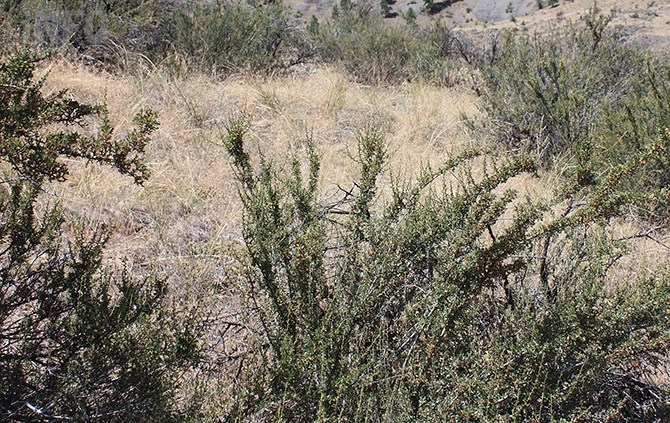
The South Okanagan is home to desert habitat such as Antelope brush sub-steppe grasslands.
(STEVE ARSTAD / iNFOnews.ca)
— This story was originally published at 7 a.m. Aug. 8, 2020.
To contact a reporter for this story, email Steve Arstad or call 250-488-3065 or email the editor. You can also submit photos, videos or news tips to tips@infonews.ca and be entered to win a monthly prize draw.
We welcome your comments and opinions on our stories but play nice. We won't censor or delete comments unless they contain off-topic statements or links, unnecessary vulgarity, false facts, spam or obviously fake profiles. If you have any concerns about what you see in comments, email the editor in the link above.
News from © iNFOnews, 2021